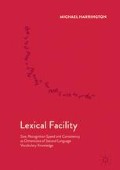Abstract
This chapter examines vocabulary size as a dimension of second language (L2) vocabulary skill. The vocabulary size research literature is introduced and research methods used to study it are described. The use of frequency statistics to estimate vocabulary size is introduced and the relationship of vocabulary size measures to L2 performance is explained.
Access this chapter
Tax calculation will be finalised at checkout
Purchases are for personal use only
References
Adelman, J. S., Brown, G. D. A., & Quesada, J. F. (2006). Contextual diversity, not word frequency, determines word-naming and reading times. Psychological Science, 17(9), 814–823.
Adolphs, S., & Schmitt, N. (2003). Lexical coverage of spoken discourse. Applied Linguistics, 24(4), 425–438.
Aitchison, J. (2012). Words in the mind: An introduction to the mental lexicon (4th ed.). Malden: Wiley.
Andrews, S. (2008). Lexical expertise and reading skill. In B. H. Ross (Ed.), The psychology of learning and motivation: Advances in research and theory (Vol. 49, pp. 247–281). San Diego: Elsevier.
Bauer, L., & Nation, I. S. P. (1993). Word families. International Journal of Lexicography, 6(4), 253–279.
Biber, D., Conrad, S., & Reppen, R. (1998). Corpus linguistics: Investigating language structure and use. Cambridge: Cambridge University Press.
Cobb, T. (2007). Computing the vocabulary demands of L2 reading. Language Learning & Technology, 11(3), 38–63.
Crossely, S. A., Subtirelu, N., & Salsbury, T. (2013). Frequency effects or context effects in second language word learning. Studies in Second Language Acquisition, 35(4), 727–755. doi:10.1017/S0272263113000375.
Ellis, N. C. (2002). Frequency effects in language processing: A review with implications for theories of implicit and explicit language acquisition. Studies in Second Language Acquisition, 24(2), 143–188.
Harrington, M., & Carey, M. (2009). The online yes/no test as a placement tool. System, 37(4), 614–626. doi:10.1016/j.system.2009.09.006.
Hazenberg, S., & Hulstijn, J. H. (1996). Defining a minimal receptive vocabulary for non-native university students: An empirical investigation. Applied Linguistics, 17(2), 145–163.
Hirsh, D., & Nation, P. (1992). What vocabulary size is needed to read unsimplified texts for pleasure? Reading in a Foreign Language, 8(2), 689–696.
Hsueh-Chao, M. H., & Nation, I. S. P. (2000). Unknown vocabulary density and reading comprehension. Reading in a Foreign Language, 13(1), 403–430.
Laufer, B. (1989). What percentage of text-lexis is essential for comprehension? In C. Lauren & M. Nordman (Eds.), Special language: From humans thinking to thinking, machines (pp. 316–323). Clevedon: Multilingual Matters.
Laufer, B. (1992). How much lexis is necessary for reading comprehension? In P. J. L. Arnaud & H. Béjoint (Eds.), Vocabulary and applied linguistics (pp. 126–132). London: Macmillan. doi:10.1007/978-1-349-12396-4_12.
Laufer, B. (2001). Quantitative evaluation of vocabulary: How it can be done and what it was good for. In C. Elder, K. Hill, A. Brown, N. Iwashita, L. Grove, T. Lumley, & T. MacNamara (Eds.), Experimenting with uncertainty: Essays in hounour of Alan Davies (pp. 241–250). Cambridge: Cambridge University Press.
Laufer, B., & Ravenhorts-Kalovski, G. C. (2010). Lexical threshold revisited: Lexical text coverage, learners’ vocabulary size and reading comprehension. Reading in a Foreign Language, 22(1), 15–30.
Leech, G., Rayson, P., & Wilson, A. (2001). Word frequencies in spoken and written English. London: Longman.
Lightbown, P. M., & Spada, N. (2013). How languages are learned (4th ed.). Oxford: Oxford University Press.
McCarthy, M. (1998). Spoken language and applied linguistics. Cambridge: Cambridge University Press.
Meara, P., & Buxton, B. (1987). An alternative to multiple choice vocabulary tests. Language Testing, 4(2), 142–145.
Meara, P., & Jones, G. (1988). Vocabulary size as placement indicator. In P. Grunwell (Ed.), Applied linguistics in society (pp. 80–87). London: CILT.
Milton, J. (2009). Measuring second language vocabulary acquisition. Bristol: Multilingual Matters.
Nagy, W. E., Anderson, R., Schommer, M., Scott, J. A., & Stallman, A. (1989). Morphological families in the internal lexicon. Reading Research Quarterly, 24(3), 263–282. doi:10.2307/747770.
Nation, I. S. P. (2006). How large a vocabulary was needed for reading and listening? The Canadian Modern Language Review/La Revue Canadienne des Langues Vivantes, 63(1), 59–82.
Nation, I. S. P. (2013). Learning vocabulary in another language (2nd ed.). Cambridge, UK: Cambridge University Press.
Paradis, M. (2009). Declarative and procedural determinants of second languages (Vol. 40). Amsterdam: John Benjamins Publishing.
Qian, D. D. (1999). Assessing the roles of depth and breadth of vocabulary knowledge in reading comprehension. The Canadian Modern Language Review, 56(2), 282–307.
Read, J. (2004). Plumbing the depths: How should the construct of vocabulary knowledge be defined? In P. Bogaards & B. Laufer (Eds.), Vocabulary in a second language: Selection, acquisition, and testing (pp. 209–227). Amsterdam: John Benjamins.
Richards, J. C. (1976). The role of vocabulary teaching. TESOL Quarterly, 10, 77–89.
Richards, B. (1987). Type/token ratios: What do they really tell us? Journal of Child Language, 14(2), 201–209. doi:10.1017/S0305000900012885.
Schmitt, N. (2010). Researching vocabulary. A vocabulary research manual. Basingstoke: Palgrave Macmillan.
Schmitt, N., & Zimmerman, C. B. (2002). Derivative word forms: What do learners know? TESOL Quarterly, 36(2), 145–171. doi:10.2307/3588328.
Schmitt, N., Jiang, X., & Grabe, W. (2011). The percentage of words known in a text and reading comprehension. The Modern Language Journal, 95(1), 26–43. doi:10.1111/j.1540-4781.2011.01146.x.
van Zeeland, H., & Schmitt, N. (2013). Lexical coverage in L1 and L2 listening comprehension: The same or different from reading comprehension? Applied Linguistics, 34(4), 457–479.
Vermeer, A. (2001). Breadth and depth of vocabulary in relation to L1/L2 acquisition and frequency of input. Applied PsychoLinguistics, 22(2), 217–234.
Webb, S., & Rodgers, M. P. H. (2009). The lexical coverage of movies. Applied Linguistics, 30(3), 407–427. doi:10.1093/applin/amp010.
Wray, A. (2008). Formulaic language: Pushing the boundaries. Oxford: Oxford University Press.
Author information
Authors and Affiliations
Copyright information
© 2018 The Author(s)
About this chapter
Cite this chapter
Harrington, M. (2018). Size as a Dimension of L2 Vocabulary Skill. In: Lexical Facility. Palgrave Macmillan, London. https://doi.org/10.1057/978-1-137-37262-8_1
Download citation
DOI: https://doi.org/10.1057/978-1-137-37262-8_1
Published:
Publisher Name: Palgrave Macmillan, London
Print ISBN: 978-1-137-37261-1
Online ISBN: 978-1-137-37262-8
eBook Packages: Social SciencesSocial Sciences (R0)

